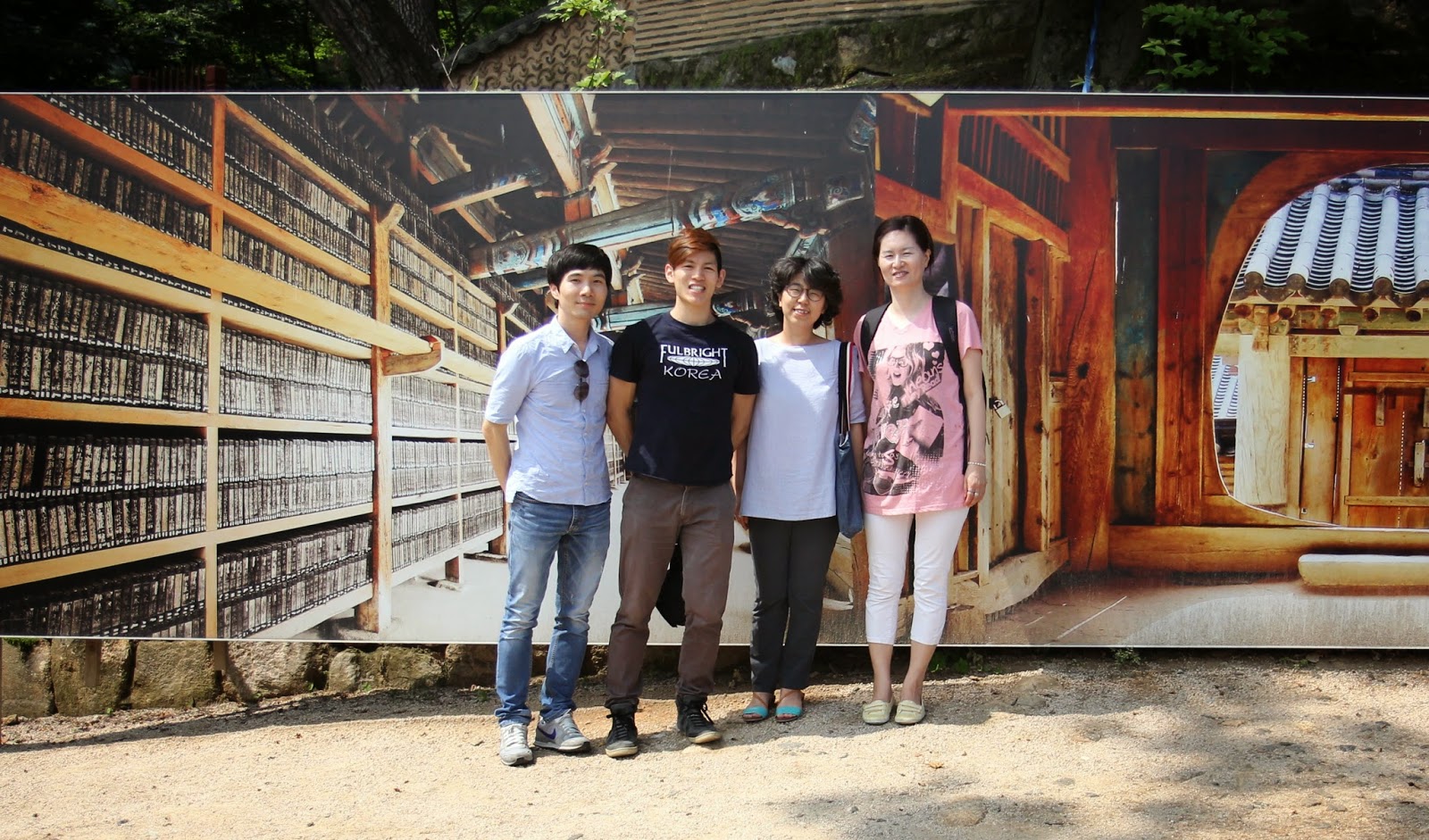 |
| 伽倻山海印寺, 가야산해인사, Gayasan Haeinsa |
The Three Jewels of Buddhism (삼보/三寶) are its three principle objects of guidance:
1. Buddha himself (불/佛), which usually refers to sarira, or holy relics
2. Dharma (법/法), or the teachings of Buddhism
3. Sangha (승/僧), the Buddhist community, which usually refers to monks and nuns
Each of these Jewels is represented by one of the Jewel Temples. Songgwangsa has a famous monk training center, so it represents 승. Tongdosa has a famous pagoda that supposedly houses some of the Buddha's remains; it represents 불. Haeinsa, then, is the symbol of 법. What Haeinsa is renowned for is the Tripitaka Koreana (팔만 대장경), an ancient collection of 80,000 wooden printing blocks that contains the complete Buddhist scriptures.
 |
| My co-teachers and me at Haeinsa. No photos allowed of the real Tripitaka Koreana, so this poster had to suffice! |
Today, I went on a field trip to Haeinsa with the English department faculty. It's the middle of finals week, so we don't have much work to do. The school sponsored our trip, partly as a way to thank me for my two years at the school, and partly because they probably realized that I have never done anything "just for fun" with my co-teachers. I mean, we attended a TOEFL conference last fall, and we go to the all-faculty outings, but this was actually the first time that just the four of us did something together that was unrelated to work!
I really enjoyed it as a change of pace. I've been constantly busy for months now, and to be able to take a break in the middle of the week for the first time since April was delightful. It helped that today was a gorgeous day, humid but not overwhelmingly hot. Also, since it was a weekday, the temple had very few visitors. I'm sure that on weekends, the grounds are buzzing with tourists, but it was peaceful and serene today. Like all Korean temples, it was gorgeous, and the natural environment was refreshing. The air somehow tasted better than it does in factory-clogged Changwon.
 |
| One of the smaller buildings in the Haeinsa temple complex. The colors are amazing! |
Our vice principal wanted to make sure that I got a bit of cultural education out of the excursion, so here's what I learned: Haeinsa is located near Mt. Gaya (in Gayasan National Park). Mt. Gaya is a spiritual place important to Buddhism; the name may refer to the place in India where Buddha achieved enlightenment or to the ancient Korean Gaya Confederacy, which was annexed by the Silla kingdom in the 6th century. Haeinsa was founded in the year 802 during the Silla period. It has been renovated many times due to damage from fire and war, most recently in 1964, I believe. This was two years after Korea added the Tripitaka Koreana to its list of national treasures. In 1995, the temple and the scriptures were added to the UNESCO World Heritage list.
The name Haeinsa is a bit odd, because, according to the plaque I read, it refers to a Buddhist philosophical state of consciousness during which "a reflection on a calm sea after struggling against wind and waves enables everything to be conscious of its true nature." It's a nice concept, of course, but I don't understand why this temple located nowhere near the ocean has such a name.
 |
| The lantern-lined labyrinth of the temple grounds. Once you enter, you have no choice to walk the entire thing! |
This temple came to house the famous Buddhist scriptures in 1398. The Tripitaka Koreana is the world's oldest and most complete version of the Buddhist scriptures in Chinese script (한자). There are 81,350 wooden printing blocks into which are carved over 52 million Chinese characters! The entire thing took 16 years to complete.
All of these blocks are currently housed in a special building at the top of a hill overlooking the rest of the complex. We were not allowed inside the building or even to take photos, but it honestly didn't look so impressive. It reminded me of the basement stacks of a library: rows and rows of heavy old books that nobody ever touches. Still, I was in awe, just knowing what was inside the room as we peered through the windows. Although the building is plain, it is said to have been designed in such a way that the wooden blocks can stay in their preserved state for centuries -- and they certainly have!
 |
| A gorgeous panel painting inside the main hall, 대적광전 (Daejeokkwangjeon). |
The one below is a bronze sculpture of a Sitting Buddha that has been split cleanly in half. Its title was something like, "The Sound of Buddha"; I can't recall correctly. But it was quite mesmerizing.
 |
| What's in the space between? |
 |
| It reminds me a bit of Burning Man... |
I'm still feeling quite relaxed from our trip, and I am so very glad we were given this opportunity. Now that I have two of the Three Jewel Temples down, why shouldn't I try for the third? Yangsan is only an hour away!
- - -
If you want to visit Haeinsa, the Korea tourism website can help you! If you don't have a car, you'll have to go via bus from Daegu Seobu Terminal, which takes an hour and a half. Temple stays are offered and weekends.
red light sauna
ReplyDeleteWAJA sauna is specialist manufacturer of top quality sauna products. Products include sauna rooms, steam rooms, barrel saunas, wooden hot tubs, and all kinds of sauna accessories.